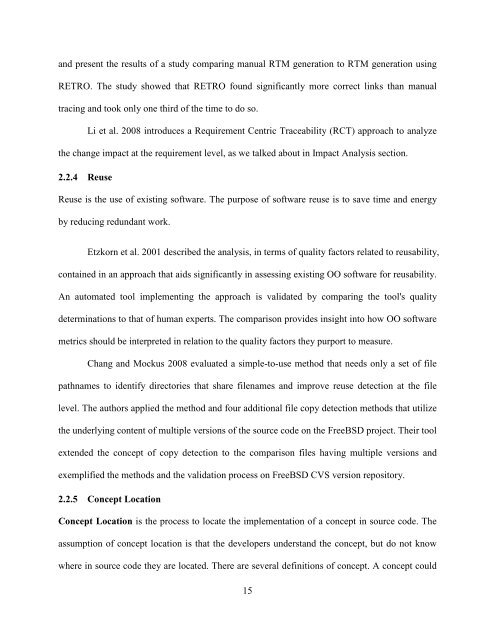COMBINING INFORMATION RETRIEVAL MODULES AND ...
COMBINING INFORMATION RETRIEVAL MODULES AND ...
COMBINING INFORMATION RETRIEVAL MODULES AND ...
Create successful ePaper yourself
Turn your PDF publications into a flip-book with our unique Google optimized e-Paper software.
and present the results of a study comparing manual RTM generation to RTM generation using<br />
RETRO. The study showed that RETRO found significantly more correct links than manual<br />
tracing and took only one third of the time to do so.<br />
Li et al. 2008 introduces a Requirement Centric Traceability (RCT) approach to analyze<br />
the change impact at the requirement level, as we talked about in Impact Analysis section.<br />
2.2.4 Reuse<br />
Reuse is the use of existing software. The purpose of software reuse is to save time and energy<br />
by reducing redundant work.<br />
Etzkorn et al. 2001 described the analysis, in terms of quality factors related to reusability,<br />
contained in an approach that aids significantly in assessing existing OO software for reusability.<br />
An automated tool implementing the approach is validated by comparing the tool's quality<br />
determinations to that of human experts. The comparison provides insight into how OO software<br />
metrics should be interpreted in relation to the quality factors they purport to measure.<br />
Chang and Mockus 2008 evaluated a simple-to-use method that needs only a set of file<br />
pathnames to identify directories that share filenames and improve reuse detection at the file<br />
level. The authors applied the method and four additional file copy detection methods that utilize<br />
the underlying content of multiple versions of the source code on the FreeBSD project. Their tool<br />
extended the concept of copy detection to the comparison files having multiple versions and<br />
exemplified the methods and the validation process on FreeBSD CVS version repository.<br />
2.2.5 Concept Location<br />
Concept Location is the process to locate the implementation of a concept in source code. The<br />
assumption of concept location is that the developers understand the concept, but do not know<br />
where in source code they are located. There are several definitions of concept. A concept could<br />
15
















